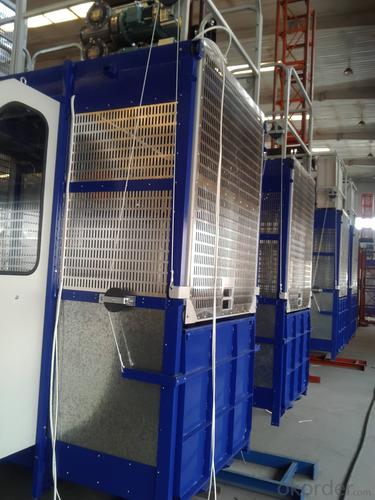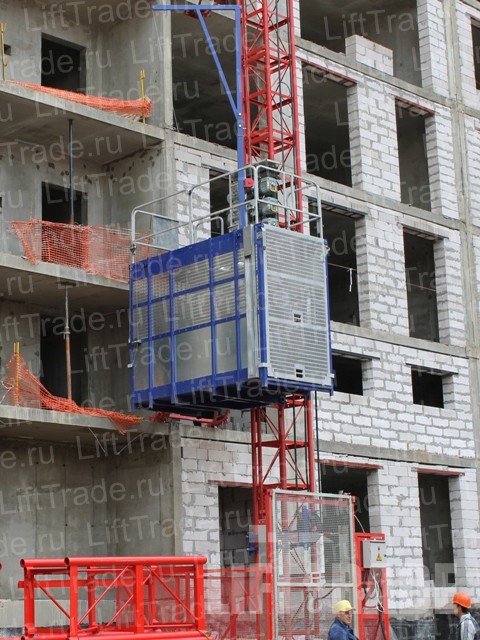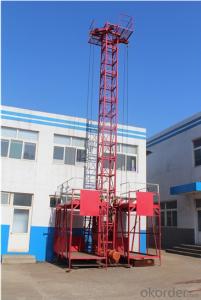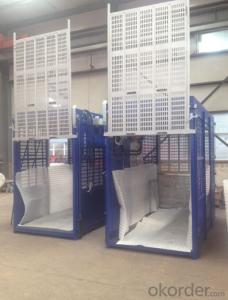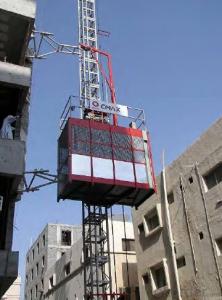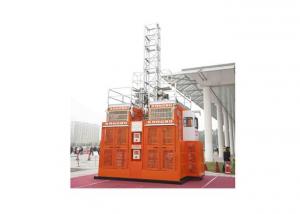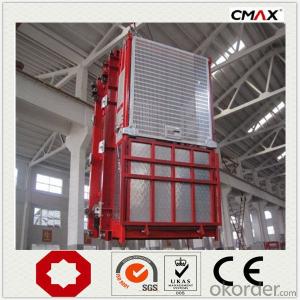One Ton Capacity Building Hoist
- Loading Port:
- Tianjin
- Payment Terms:
- TT or LC
- Min Order Qty:
- -
- Supply Capability:
- 40 units unit/month
OKorder Service Pledge
OKorder Financial Service
You Might Also Like
Building hoist
1, Two cage
2, maximum capacity:1Ton/cage
3, Middle speed:0-60m/min
4, Main part welded by robot
The Construction Hoist is set up with frequency conversion and twin cages. Every cage has two suits of independent driving mechanism.With the technology of frequency conversion the construction hoist driven by rack and pinion can speed up and slow down steadily. It has features such as:
1. Starting and braking are steady with no impact.
2. The lifting speed can be controlled.
3. Starting current is lower than rated current.
4. The mechanical wear and tear is reduced evidently.
5. Power saves efficiently.
The main technical parameters of SC100/100 construction hoist ate listed as follows:
1. Lifting capacity: 2x1000kg
2. Lifting Speed: 33m/min or 60m/min with frequency inverter(Toshiba)
3. Rated Power: 2-2x11kw or 2-2x15kw
4. Mast Section Size: 650x650x1508mm, double rack, Painted or Galvanized optional
5. Delivery time: 20-25 days.
We can provide tailored design, backing on the strong technical strength of China Academy of Building Research.
Construction lift with Interver:
| Characteristics | Model | Rated Loading | Lifting Speed | Motor Power | |
| Double Cabin | Low-speed | SC200/200D | 2 × 2000kg | 0-36m/min | 2 × (3 × 11kw) 2 × (2 × 13kw) 2 ×(2 × 15kw) |
| SC100/100D | 2 × 1000kg | 0-36m/min | 2 × (2 × 11kw) | ||
| Mid-speed | SC200/200Z | 2 × 2000kg | 0-60m/min | 2 × (3 × 15kw) | |
| SC100/100Z | 2 × 1000kg | 0-60m/min | 2 × (2 × 15kw) | ||
| Single Cabin | Low-speed | SC200D | 2000kg | 0-36m/min | 3 × 11kw 2× 13kw 2× 15kw |
| SC100D | 1000kg | 0-36m/min | 2 × 11kw | ||
| Mid-speed | SC200Z | 2000kg | 0-60m/min | 3× 15kw | |
| SC100Z | 1000kg | 0-60m/min | 2 × 15kw | ||
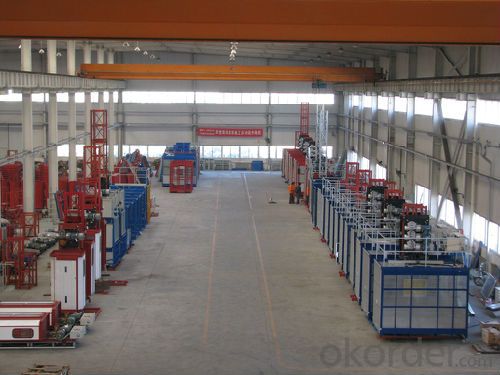
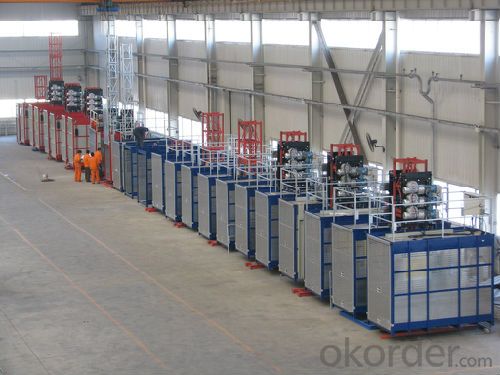
- Q: Is it possible to use a building hoist for lifting delicate or fragile items?
- <p>A building hoist is typically designed for heavy construction materials and not recommended for lifting fragile objects. The vibrations and force exerted during lifting can damage delicate items. For fragile objects, specialized hoists or cranes with controlled movements and gentle handling capabilities are advised to ensure safety and prevent damage.</p>
- Q: A building hoist is a piece of equipment used in construction to lift materials and personnel.
- <p>A building hoist, also known as a construction hoist or material hoist, is a temporary lifting device used in the construction industry to transport materials, equipment, and sometimes personnel vertically within a building under construction. It is essential for efficient movement of heavy and bulky items, reducing manual labor and improving safety by minimizing the need for workers to climb ladders or handle heavy loads manually. These hoists are typically installed on the exterior of the building and are used throughout the construction process until the building's permanent elevators are installed and operational.</p>
- Q: This question asks about the different types of hydraulic cylinders that are utilized in lifting equipment.
- <p>Hydraulic cylinders used in lifting equipment can be categorized into several types based on their design and application. The main types include: single-acting cylinders, which have one port for fluid and rely on the load or a spring to return; double-acting cylinders, which have ports on both ends and can extend and retract through fluid pressure; telescopic cylinders, which consist of multiple stages that can extend sequentially for greater reach; and rotary hydraulic cylinders, which provide a combination of linear and rotary motion. Each type is chosen based on the specific requirements of the lifting task, such as the need for speed, force, and control.</p>
- Q: Is it permissible to use a building hoist for the purpose of lifting hazardous materials?
- <p>A building hoist is typically not designed for lifting dangerous materials. It is meant for the transportation of construction materials and personnel within a building. Lifting hazardous materials requires specialized equipment and procedures to ensure safety. Always refer to the manufacturer's guidelines and local regulations for the appropriate use of hoisting equipment and handling of dangerous materials.</p>
- Q: Is it possible to use a building hoist for the transportation of goods or materials?
- <p>Yes, building hoists are commonly used to transport goods and materials in construction projects. They are designed to lift and lower heavy materials such as bricks, cement, and tools, making the construction process more efficient and reducing the need for manual labor. Building hoists are equipped with safety features to ensure the secure transportation of materials, and they are an essential tool in many construction sites.</p>
- Q: Is it possible to utilize a building hoist to lift objects with varying dimensions and weights?
- <p>Yes, building hoists are designed to lift a variety of objects with different sizes and weights. However, each hoist has specific weight and size limitations that must be adhered to for safety and operational reasons. It's crucial to ensure that the objects being lifted are within the hoist's capacity to prevent accidents and damage. Always consult the manufacturer's specifications and safety guidelines before using a hoist for lifting operations.</p>
- Q: Is it possible to store lifting equipment in a residential setting such as a home or garage?
- <p>Yes, you can store your lifting equipment in your home or garage, but there are several considerations to keep in mind. Ensure that the space is dry, well-ventilated, and free from extreme temperatures to prevent rust or damage. Store equipment on stable, level surfaces to prevent tipping. Keep equipment away from children and pets for safety. Regularly inspect equipment for wear and tear, and store it properly when not in use to maintain its condition. Always follow the manufacturer's guidelines for storage to ensure the longevity and safety of your equipment.</p>
- Q: How large a leakage protector is used for the construction elevator
- If it is 33KW, direct start, single cage, 160A, leakage action current 50ma-75ma, movement time 0.1 s, electrical machine leakage protector. The best.
- Q: What types of materials can be transported using a building hoist?
- <p>A building hoist can lift a variety of materials, including construction supplies such as bricks, cement, sand, and gravel. It can also transport larger items like steel beams, prefabricated concrete elements, and heavy machinery. Additionally, it is used to move tools, equipment, and sometimes personnel within the construction site. The specific materials that can be lifted depend on the hoist's capacity and the safety regulations in place. It's crucial to ensure that the load does not exceed the hoist's weight limit to maintain safety standards.</p>
- Q: This question asks about the typical issues encountered with construction hoists and seeks solutions to address these problems.
- <p>Common problems with building hoists include mechanical failures, electrical issues, safety hazards, and improper maintenance. Mechanical failures can be fixed by regular inspection and timely replacement of worn-out parts. Electrical issues are often resolved by checking wiring and connections, and using surge protectors. Safety hazards can be mitigated by ensuring all safety features are operational and by providing proper training to operators. Improper maintenance can be addressed by establishing a routine maintenance schedule and ensuring that all personnel follow safety protocols. Regular inspections, prompt repairs, and operator training are key to maintaining the functionality and safety of building hoists.</p>
Send your message to us
One Ton Capacity Building Hoist
- Loading Port:
- Tianjin
- Payment Terms:
- TT or LC
- Min Order Qty:
- -
- Supply Capability:
- 40 units unit/month
OKorder Service Pledge
OKorder Financial Service
Similar products
Hot products
Hot Searches
Related keywords


